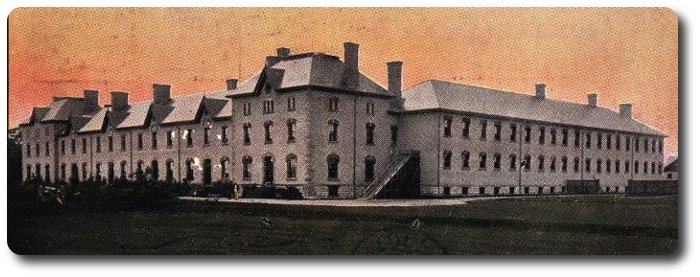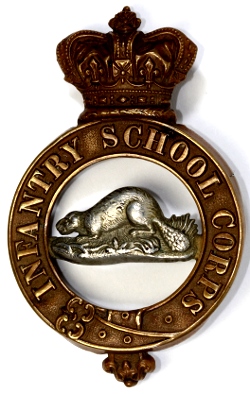
Our Permanent Troops
"D" Company, Infantry School Corps, London, Ont.
The Dominion Illustrated, 28th February, 1891
 This Company was the last formed of the corps, or regiment, known as the Infantry School Corps; therefore, all the history related of the other companies belongs to it also, more especially as all its present combatant officers, with one exception have served with the other companies.
This Company was the last formed of the corps, or regiment, known as the Infantry School Corps; therefore, all the history related of the other companies belongs to it also, more especially as all its present combatant officers, with one exception have served with the other companies.
In the 1st of July, 1886, Sir Adolphe P. Caron laid the foundation stone of the Infantry baracks at London, Ontario. The building is of white brick, with red stone facings. The site is on the ground purchased by the City from the Hon. John Carling, and is sutuated north-east of the town, about two miles from the post office.
A great deal of time and money was lost by the discovery that the sub-soil was of shifting sand, and the boiler house, which was built for heating the buildings throughout, was sunk 30 feet before anything like a solid foundation was found.
The exterior of the barracks, as will be seen from the illustrations, has not a very military appearance, nor are the internal arrangements as appropriate as might have been expected when new barracks were being built.
On the 19th of July, 1887, Major Smith, commanding "C" Company at Toronto, was detached from "C" Company, and was appointed Commandant of the Royal School of Infantry at London, with the rank of Lieut.-Colonel in the Infantry School Corps. It was not, however, until the 24th December of that year that recruiting commenced, owing to the delay in completing the barracks; but from this date till the 5th April, 1888. Lieut.-Colonel Smith was alone with no officer to assist him; and no one who has not had the experience of starting a new regular corps in a new barrack, can have any idea of the amount of work he had to do; luckily, he had as Sergt.-Major, Sergt.-Major Munro, late of "C" Company. On the 5th April, Lieut. Wadmore, also of "C" Company, was sent up to assist him. These two officers, who had been together since the inception of the corps in 1883, carried on all company and school work till the end of June, when Lieuts. Denison and Evans were gazetted to the corps and posted to "D" Company, which had not yet, however, a captain. In August, 1888, Capt. Frere, a captain in the army, but not in the Corps, and Adjutant of "B" Company, was sent up to command it, which he did until the 21st December, 1888, when he left to rejoin his regiment, "The South Staffordshire," much to the regret of the officers, N.C. officers and men, to whom he had much enared himself by his generous heart and kindly manner.
It was not until Match, 1889, that the captain of "D" Company was gazetted, when Lieut. D.D. Young, adjutant of "A" Company, and senior subaltern of the regiment obtained his promotion.
The surgeon was appointed in September, 1888, namely, Surgeon Hanavan, formerly of the 28th., Stratford—Surgeon Fraser, of the 7th Batt., having in the meantime looked after the medical examination of recruits and attended the hospital, which is at present a portion of the barracks used for that purpose; a proper detached hospital, drill shed, married quarters and stables being needed to make them complete.
On the 12th April, 1889, Lieut. and Captain Cartwright was transferred from "C" Company to "D"; and Lieut. Evans sent from "D" to "C" Company in his place. The officers, at the present date, with "D" Company are as follows:—
- Lieut.-Col. Smith, Commandant.
- Captain D.D. Young.
- Lieut. and Capt. R.L. Wadmore.
- Lieut. and Capt. R. Catwright.
- Lieut. S.A. Denison.
- Surgeon M.J. Hanavan.
Lieut.-Col. Smith is also D.A.G., or officer commanding Military District No. 1.
The various illustrations speak for themselves. The physical training is done entirely to music, no single word of command being used when the men are fully trained. The fire picquet and the men in barracks turned out as if for a fire; the men drill at the reels as if they were field guns. On one occasion this picquet, without previous warning, turned out and had water playing on the building in 45 seconds from the first sound of the bugle.
The rifle team are the picked men of the best shooting company of the whole permanent corps. The cup shown is one given by the Hon. J. Carling, to be shot for by the Royal School of Infantry at London and the 7th Batt., and is to be kept by the team winning it three times running. The 7th Batt. won it in 1889, the R.S.I. in 1890.
It would be well, before completing this short account, to pint out the common mistake that is made with regard to our permanent infantry. It is the practice to call them "A," "B," "C" and "D" Schools, when in reality and according to the official militia list, they are "A," "B," "C" and "D" Companies of the Regiment called the Infantry School Corps. This error has no doubt arisen from the fact that each of the companies at present forms school of instruction for the training of officers, N.C. officers and men of the militia, who during their course are attached to these companies respectively. It is curious to observe that the public have never fallen into the same error with the permanent artillery, the units of which are always designated "A," "B" and "C" Batteries, and not "A," "B" and "C" Schools.

